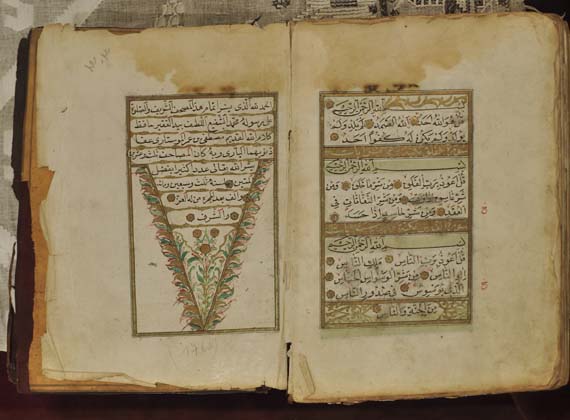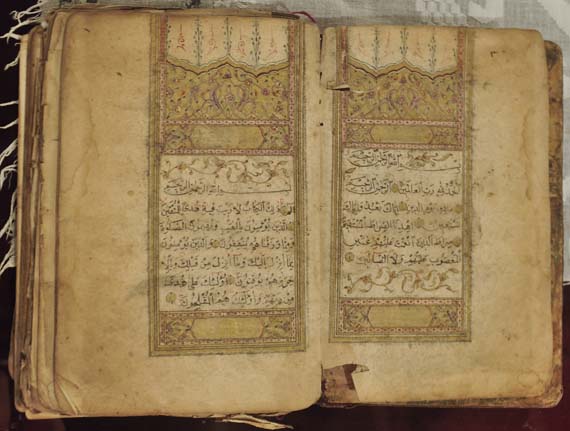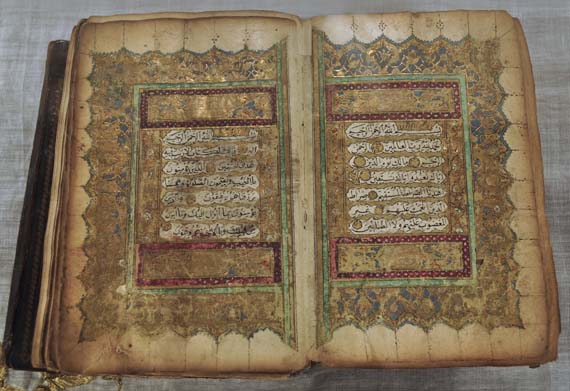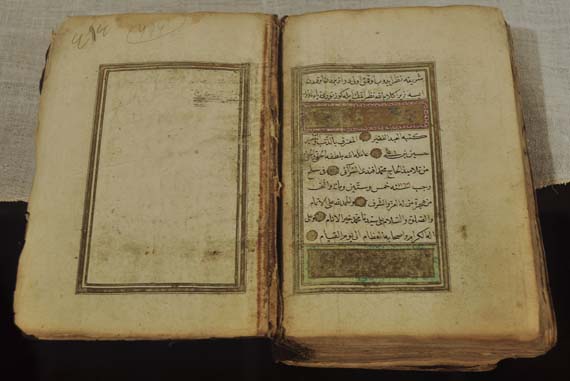Manuscripts of the Quran - part 2
Nov 17, 2010 FEATURE, Manuscripts
Qur’an / Fol. 316; 19 x 12,2 cm; 15 lines. Naskh, vocalized, written by a very skilful hand. The ink is black and of poor quality, unsteady in contact with moisture. Titles of surahs are written in white ink on a golden background, with marks of the beginning of sections (juz’), halves of sections and quarter od sections, and Sajda marks written in gold letters in the margins. Large ornamental circles indicating ends of ayahs are also done in gold letters. At beginnings of surahs there are beautifully done ‘unwans in the shape if diptychs, richly decorated in gold colour. In the central part of the outer side of the cover fold, there are longitudinal rosettes covered by stylized floral decoration embossed as delicate, precise relief in thick gilded leather. At the end of the manuscript, there is a note stating that its copy was completed by Mustafa muezzin b. al-Hagg Mahmud in the month of Ramadan of 1095 (August 1684) / Photo © Islamic Arts Magazine
 Qur’an / Fol. 303; 19,5 x 13,5 cm; 15 lines. Naskh, vocalized, written by a very skilful hand. Surah al-Fatiha and the beginning of Surah al-Baqara are done in the shape of diptychs, with floral motifs and dominant gold and deep blue colours. The paper is thin, and smooth, with a watermark, of European origin. On Fol.303a there is a colophon with a note stating that it is the 23rd copy made by Mustafa b. Umar a-Mostari and that the copy was completed in 1173/ 1759. / Photo © Islamic Arts Magazine
Qur’an / Fol. 303; 19,5 x 13,5 cm; 15 lines. Naskh, vocalized, written by a very skilful hand. Surah al-Fatiha and the beginning of Surah al-Baqara are done in the shape of diptychs, with floral motifs and dominant gold and deep blue colours. The paper is thin, and smooth, with a watermark, of European origin. On Fol.303a there is a colophon with a note stating that it is the 23rd copy made by Mustafa b. Umar a-Mostari and that the copy was completed in 1173/ 1759. / Photo © Islamic Arts Magazine
 Qur’an / Fol. 302; 19,5 x 12,4 cm; 15 lines. Naskh, vocalized, written by a very skilful hand. Surah al-Fatiha and the beginning of Surah al-Baqara are done in the shape of diptychs, on a gold background with floral motifs. At beginning of other surahs, there are ‘unwans on a gold background with the surah title, ayah’s number and revelation place written in white letters. Original semi-leather binding. On the outer side of the cover, there are imprinted decorative rosettes with floral motifs. On Fol. 300a there is a note in Turkish added afterwards stating that the Mushaf was completed on the 18th of Rabi’ al-a 1114 (September 10th 1702). / Photo © Islamic Arts Magazine
Qur’an / Fol. 302; 19,5 x 12,4 cm; 15 lines. Naskh, vocalized, written by a very skilful hand. Surah al-Fatiha and the beginning of Surah al-Baqara are done in the shape of diptychs, on a gold background with floral motifs. At beginning of other surahs, there are ‘unwans on a gold background with the surah title, ayah’s number and revelation place written in white letters. Original semi-leather binding. On the outer side of the cover, there are imprinted decorative rosettes with floral motifs. On Fol. 300a there is a note in Turkish added afterwards stating that the Mushaf was completed on the 18th of Rabi’ al-a 1114 (September 10th 1702). / Photo © Islamic Arts Magazine
 Qur’an / Fol. 375; 16 x 9,8 cm; 15 lines. Naskh, vocalized, written by a very skilful hand. Surah al-Fatiha and the beginning of Surah al-Baqara are done in the shape of diptychs, richly decorated with floral motifs. Ornamental circles indicating the ends of ayahs are done in large letters in gold colour. Marks of beginnings of sections (juz’), parts of sections and sajda marks done in the shape of elongated rosettes with floral motifs, richly decorated in gold, blue, orange and green colours. No data about the scribe or the place or year when the copy was made. judging by the paper, script, ink and binding, the copy most probably dates back to the 18th century. / Photo © Islamic Arts Magazine
Qur’an / Fol. 375; 16 x 9,8 cm; 15 lines. Naskh, vocalized, written by a very skilful hand. Surah al-Fatiha and the beginning of Surah al-Baqara are done in the shape of diptychs, richly decorated with floral motifs. Ornamental circles indicating the ends of ayahs are done in large letters in gold colour. Marks of beginnings of sections (juz’), parts of sections and sajda marks done in the shape of elongated rosettes with floral motifs, richly decorated in gold, blue, orange and green colours. No data about the scribe or the place or year when the copy was made. judging by the paper, script, ink and binding, the copy most probably dates back to the 18th century. / Photo © Islamic Arts Magazine
 Qur’an / Fol. 375; 16 x 9,8 cm; 15 lines. Naskh, vocalized, written by a very skilful hand. Surah al-Fatiha and the beginning of Surah al-Baqara are done in the shape of diptychs, richly decorated with floral motifs in the dominant gold colour. The paper is of medium thickness, smooth, in a dark shade of white, with a watermark, of Eastern origin. On the outer side of the cover, there are imprinted decorative ornaments with floral motifs. On fol. 413b there is a note stating that a copy was completed by Husayn, the son of Ali, a student of Haji Muhammad Efendi Sarajevan, on the last day of Rajab 1165 (June 13th 1752). / Photo © Islamic Arts Magazine/span>
Qur’an / Fol. 375; 16 x 9,8 cm; 15 lines. Naskh, vocalized, written by a very skilful hand. Surah al-Fatiha and the beginning of Surah al-Baqara are done in the shape of diptychs, richly decorated with floral motifs in the dominant gold colour. The paper is of medium thickness, smooth, in a dark shade of white, with a watermark, of Eastern origin. On the outer side of the cover, there are imprinted decorative ornaments with floral motifs. On fol. 413b there is a note stating that a copy was completed by Husayn, the son of Ali, a student of Haji Muhammad Efendi Sarajevan, on the last day of Rajab 1165 (June 13th 1752). / Photo © Islamic Arts Magazine/span>
Comments
Add a comment